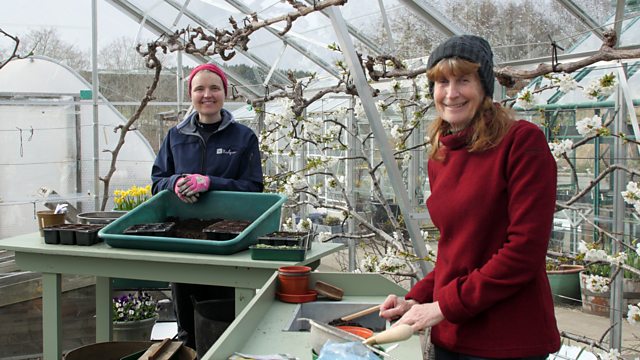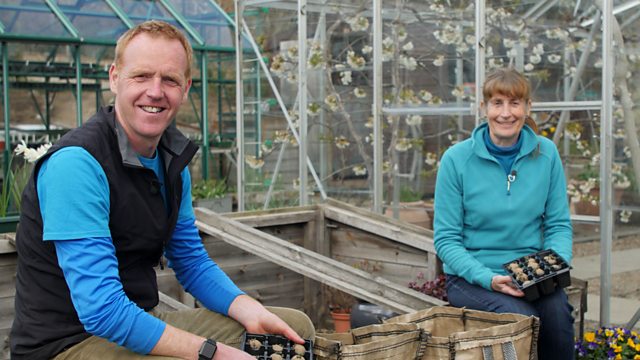The Beechgrove Garden 2021 episode 17: It’s cherry harvest and cherry-tasting time in both Beechgrove and in sunny Joppa. Also at Beechgrove, Kirsty creates a green talking point for any stylish home by taking a recycled picture frame and creating an easy-to-copy piece of living wall art with succulents.
There are two inspirational garden visits this week – inspirational upcycler Lynn Cameron has created a gorgeous garden in Alva out of what others might regard as rubbish, while Ryan Adam has single-handedly built a garden for his new-build home from the rubble that the builders leave behind.
The Beechgrove Garden 2021 episode 17
Cherries
Sweet cherries produce delicious fruit and are usually grown as small open trees, or trained as fans against walls or fences. They can also be grown in large containers – and if you choose a self-fertile cultivar, they will fruit without a pollination partner. Acid cherries are self-fertile, tolerate some shade and are ideal for a north-facing wall. Their fruits are excellent for cooking and make delicious jam.
In late winter, feed with a high potassium general fertiliser, such as Vitax Q4. Scatter two handfuls per square metre/yard around trees growing in bare soil, and two and a half around those growing in grass. Protect cherry flowers from frost damage – cover with horticultural fleece if frost is predicted. Keep trees well watered during the early stages of fruit development.
Sweet cherries are usually grown as small trees (‘open-centred bush’ or ‘pyramid’), or fans against a wall or fence. Sweet cherries fruit on one-year-old and older wood; pruning creates a balance between older fruiting wood and younger replacement branches. Formative pruning takes place in spring as the buds begin to open, established trees are pruned from late July to the end August. For pruning of mature fan trees and for pruning of bush sweet and acid cherry trees, read more in our advice profile.
Cacti and succulents
This plant group is extremely vast and diverse, from the very small and intricate to the striking and architectural. There is a cactus or succulent to suit everyone, whether young or old. The common linking characteristic of cacti and succulents is the ability to store water in the leaves or stems enabling them to survive in arid habitats. All cacti are succulents, yet cacti are defined by the presence of areoles (specialised sites where spines form) whereas succulents have none.
The majority of cacti and succulents grow in desert and savannah situations with low moisture, dry air, bright sunshine, good drainage and high temperatures. However there are succulents such as Schlumbergera and Epiphyllum which grow as epiphytes in rainforests. These require semi-shade and humid conditions. So to cultivate cacti and succulents successfully it is best to research their native habitat, to provide their ideal growing conditions as far as possible.
Cacti and succulents will perform and look better if you allow them to follow their natural seasonal pattern. A period of rest, to mimic the dry season, to be then followed by an increase in water to act as the rainy season will ensure a good display of flowers. Always check as to what seasonal treatment is required as some will need to rest in the winter to then flower in the spring, while others will rest over summer to flower in the autumn.





Pingback: The Beechgrove Garden 2021 episode 18 — HDclump